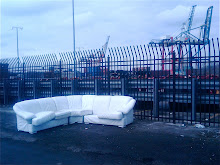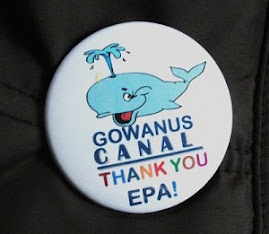 VISION 2020 DRAFT RECOMMENDATIONS - LAST CHANCE FOR PUBLIC INPUT - PUBLIC MEETING, OCT 12th, or COMMENT ON-LINE BEFORE 5pm NOVEMBER 12th
VISION 2020 DRAFT RECOMMENDATIONS - LAST CHANCE FOR PUBLIC INPUT - PUBLIC MEETING, OCT 12th, or COMMENT ON-LINE BEFORE 5pm NOVEMBER 12thFollowing a series of public workshops, the NYC Department of Planning has released a number of draft recommendations for its "Vision 2020 - NYC Comprehensive Waterfront Plan" - a plan that hopes to shape the use of our city's waterfront for the next decade and beyond.
You can go to their web site (
here) and download the various recommendations in full (PDF) or in sections, each pertaining to the individual 5 boroughs. The section relating to Brooklyn, specifically, and our neighborhood is also available
(here), as a Google doc. The recommendations for "Reach 14 South", the section of waterfront that includes Red Hook, Cobble Hill, the Gowanus Canal area and Sunset Park can be found starting on page 5 of the Brooklyn section. You can also find, (
here), an additional section, containing broader "Programmatic Recommendations", that outlines the "recommendations for citywide policy and programmatic changes".
These are "draft" recommendations, so the Department of Planning is still looking for public input. If you would like to have
your say, you can still do so on line -
HERE - till 5 p.m., November 12th. Additionally, you can attend the final public meeting that is being held on Tuesday, October 12th. The details of the meeting from the Dept. of Planning are
here, but please find below the main details from their web site -
The Department will be holding a public meeting on October 12th. At this meeting the Department of City Planning will give a presentation, which will be followed by an opportunity for public comment. Many thanks to all those who have participated so far, and we hope you will continue to be a part of the process!
Public Meeting on Draft Recommendations
Tuesday, October 12th, 6 p.m.
Rosenthal Pavilion, NYU Kimmel Center for University Life
60 Washington Square South, 10th Floor, New York, NY
(corner of La Guardia and West 4th)
Subway:
A,B,C,D,E,F,V at West 4th St.
R,W at 8th St-NYU
6 at Astor Pl.
As the Dept. of Planning is stating, "participation is a critical component of the Vision 2020 process", so make sure you make your ideas known.
What do you think of these draft recommendations for Red Hook and surrounds? (click to enlarge) -

There's some good stuff here, but is there something else you think should be addressed? For instance, I don't see anything specific about increased access to waterborne public transportation here - ferries, water taxi. etc - at the Atlantic Basin or elsewhere. There is nothing that acknowledges Red Hook's connection to Governor's Island via its close proximity to it, or anything that works towards strengthening that connection via transportation or other means, something that would benefit our residents and small businesses. It would be a shame if Governors Island - with its new parks and other development - essentially turned its back on Red Hook, its closest neighbor.
Something that
is included in these recommendations - something that wasn't included in the initial goals set by the Dept. of Planning for "Vision 2020" - is the "
support for green port initiatives, including cold-ironing" at Piers 7-12, which would include the Brooklyn Cruise Terminal. When the initial Vision 2020 Plan was announced, there was actually no mention of the impacts of port pollution on the residents of our city. I made note of this point in my post (
here), written after attending the Brooklyn Workshop in May this year. I wrote -
"In all of the points listed in the various handouts, including the “Preliminary List of Goals and Issues” distributed at the workshop – a list that contained 7 goals, and 27 specific issues under the headings: Natural Waterfront; Working Waterfront; Public Waterfront, Mixed Use, Residential and Commercial Waterfront; and Blue Network (which includes transportation and freight movement, alternative energy, etc) - not once was mentioned the idea that the activities of the ports are actually polluting, and that the Vision 2020 Plan should acknowledge that fact and seek out a strategy to mitigate this pollution and its detrimental health effects."
It's good to see that these issues are now being taken somewhat seriously by the Dept. of Planning and not only in Brooklyn. As part of the broader section I mentioned before, (
here), titled "Programmatic Recommendations" that outlines the "recommendations for
citywide policy and programmatic changes", there is a 'goal' titled, "
Support Economic Activity on the Working Waterfront". Under this goal is a section encouraging the use of "
green technology and practices to make waterfront industrial areas and ports throughout the city more environmentally sensitive and to reduce negative impacts on neighboring residential areas". Outlined are a number of potentially port 'greening' initiatives, including encouraging the use of
shore-based power and cold ironing. If this
is a city-wide recommendation, then this is a thankful acknowledgment of the impact of port pollution on the residents of our city and the urgent need to mitigate it - especially when the Environmental Defense Fund estimates that pollution created by ships visiting the Ports of New York and New Jersey is equivalent to the pollution produced by 7.8 million new cars, and when the Port Authority itself acknowledges that the
monetized health cost of the pollution from cruise ships visiting Red Hook, Brooklyn (alone - not including the container ships) is estimated to be
$9 million a year.
Hopefully these recommendations will spur serious and urgent action on these issues - something that has been lacking so far, even with the "lowest hanging fruit" - the Brooklyn Cruise Terminal - where, despite serious commitments both financially and otherwise from the cruise operators, the Port Authority and others, the promise to initiate cold-ironing at that terminal has languished in some sort of limbo, lost in a void between the impenetrable deliberations of the Public Service Commission and a mindset at Con-Edison that refuses to provide an electricity power rate to make this practice economically viable - thereby saving lives, and taking carcinogenic gasses and asthma causing particulates out of the air and the lungs of our children in the process.
So, while you wait (don't hold your breath!) for the cold-ironing situation at the Brooklyn Cruise Terminal to be sorted out - something that
Rich Kassel from the National Resources Defense Council described as being a "no brainer" at the New York City Council's Committee on Waterfronts' "
Oversight - Clearing the Air: Greening New York City's Working Waterfront" hearing in June - have a look over these other draft recommendations.
Have a think about what you might want included in plans for our waterfront. More transportation? Better waterfront access? More connection to the upland residential and commercial communities? Creation of a connection to Governors Island? Better and more equitable use of publicly owned property - e.g. Cruise Terminal site, Atlantic Basin? More programs like the
successful ones PortSide New York mounted over the summer?
Let your thoughts be known - at the meeting, details
HERE, on Tuesday October 12th - or on-line
HERE before 5pm November 12th.

(
Photo: The Atlantic Basin and tall ship, Clipper City - an event made possible by PortSide New York)












